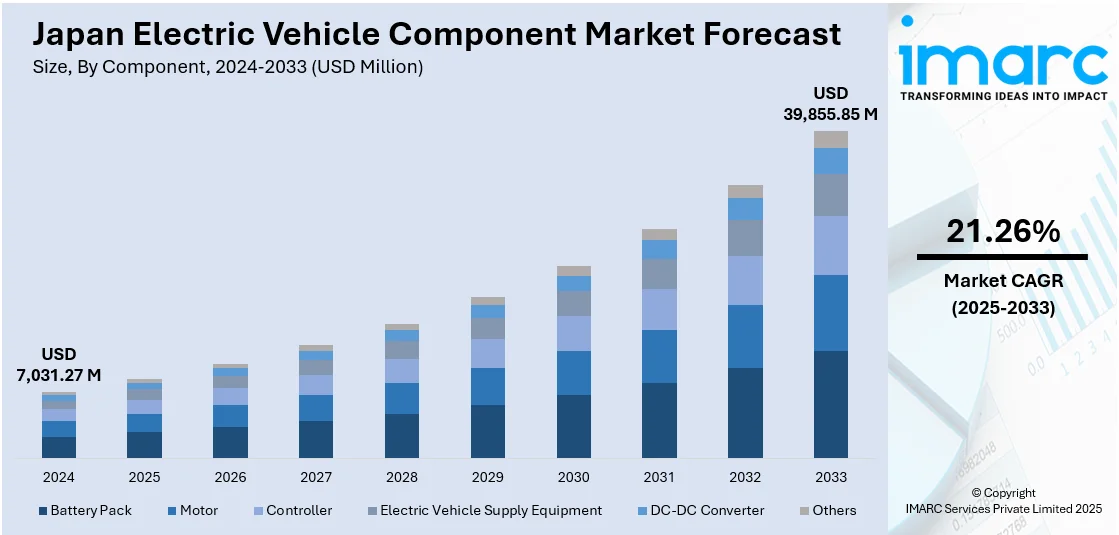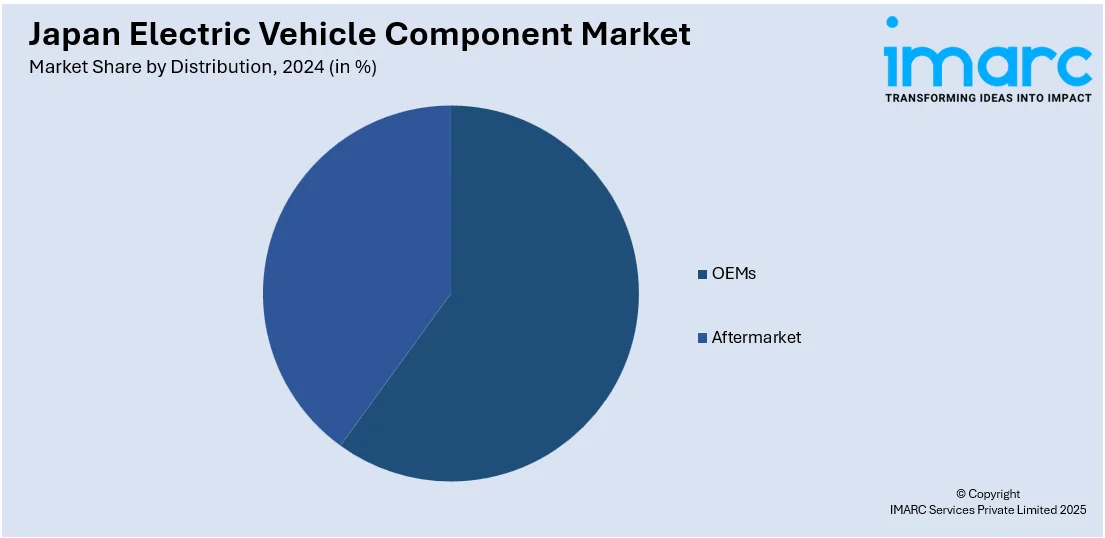
Japan Electric Vehicle Component Market Size, Share, Trends and Forecast by Component, Distribution, and Region, 2025-2033
Japan Electric Vehicle Component Market Overview:
The Japan electric vehicle component market size reached USD 7,031.27 Million in 2024. Looking forward, IMARC Group expects the market to reach USD 39,855.85 Million by 2033, exhibiting a growth rate (CAGR) of 21.26% during 2025-2033. Japan's commitment to environmental sustainability, advancements in battery technology, and government incentives and policies promoting electric vehicle (EV) adoption is driving the market growth. Moreover, the increasing demand for high-quality automotive components from leading manufacturers like Toyota and Nissan, the growing focus on renewable energy, Japan's role in autonomous and connected vehicle development, strategic collaborations between automakers and suppliers, rising consumer awareness, and the shift toward a circular economy for EV components are contributing to the Japan electric vehicle component market share.
|
Report Attribute
|
Key Statistics
|
|---|---|
|
Base Year
|
2024 |
|
Forecast Years
|
2025-2033
|
|
Historical Years
|
2019-2024
|
| Market Size in 2024 | USD 7,031.27 Million |
| Market Forecast in 2033 | USD 39,855.85 Million |
| Market Growth Rate 2025-2033 | 21.26% |
Japan Electric Vehicle Component Market Trends:
Environmental Sustainability Commitment
Japan has been a pioneer in environmental sustainability, and its commitment to reducing carbon emissions is one of the top factors driving the market growth. Along with its broader environmental agenda, the country has set ambitious targets to reach net-zero by 2050. Part of reaching this objective is the government embracing a sequence of policies and laws in favor of using cleaner technology, like electric vehicles. Support for EVs is an immediate corollary to the effort to reduce the level of greenhouse gas emissions from conventional internal combustion engine (ICE) vehicles, which is another factor supporting the Japan electric vehicle component market growth. This is further supported by the escalating demand for EV components such as batteries, electric motors, and power electronics. As Japan continues to reinforce its green transition through both national and regional incentives, the demand for advanced EV components will undoubtedly continue to rise, contributing to the overall market expansion.

Advancements in Battery Technology
Battery technology is the prime catalyst for the growth of Japan's electric vehicle (EV) component sector. Some of the world's top battery technology developers, including Panasonic and Toyota, call Japan home and are leading the development of next-generation technologies like solid-state batteries and next-generation lithium-ion solutions. The goal of these technologies is to optimize battery efficiency, energy density, and charging speed at the lowest cost. Moreover, the launch of solid-state batteries, with higher energy density and advanced safety features than traditional lithium-ion batteries, is creating a positive market outlook. Furthermore, the advancement in recycling technologies is addressing sustainability and resource scarcity problems, further accelerating the market's growth. As battery quality and price continue to improve, the efficiency and value of EV parts is projected to improve as well, which is bringing electric vehicles (EVs) within reach of consumers and fueling adoption across Japan.
Government Incentives and Policies
Government policies and incentives are the primary factors boosting the market growth. The Japanese government has introduced a number of subsidies, and tax incentives to reduce the initial cost of electric cars and promote their mass adoption. These initiatives aim to popularize EVs among the masses and convince car manufacturers to invest in new EV technology. Apart from this, Japan has imposed stringent emissions laws that compel producers and consumers to shift away from conventional gasoline-powered vehicles. Plans such as the "Green Vehicle Tax" and battery manufacturing subsidies are designed to enable the development of the EV ecosystem. With the government continuously bolstering its green policies, including expanding charging stations and promoting local EV manufacturing, the demand for essential EV components like batteries, powertrains, and charging points will continue to rise, further fueling the market growth.
Japan Electric Vehicle Component Market Segmentation:
IMARC Group provides an analysis of the key trends in each segment of the market, along with forecasts at the country and regional levels for 2025-2033. Our report has categorized the market based on component and distribution.
Component Insights:
- Battery Pack
- Motor
- Controller
- Electric Vehicle Supply Equipment
- DC-DC Converter
- Others
The report has provided a detailed breakup and analysis of the market based on the component. This includes battery pack, motor, controller, electric vehicle supply equipment, DC-DC converter, and others.
Distribution Insights:

- OEMs
- Aftermarket
A detailed breakup and analysis of the market based on distribution have also been provided in the report. This includes OEMs and the aftermarket.
Regional Insights:
- Kanto Region
- Kansai/Kinki Region
- Central/Chubu Region
- Kyushu-Okinawa Region
- Tohoku Region
- Chugoku Region
- Hokkaido Region
- Shikoku Region
The report also provides a comprehensive analysis of the major regional markets, which include the Kanto, Kansai/Kinki, Central/Chubu, Kyushu-Okinawa, Tohoku, Chugoku, Hokkaido, and Shikoku regions.
Competitive Landscape:
The market research report has also provided a comprehensive analysis of the competitive landscape. Competitive analysis such as market structure, key player positioning, top winning strategies, competitive dashboard, and company evaluation quadrant has been covered in the report. Also, detailed profiles of all major companies have been provided.
Japan Electric Vehicle Component Market News:
- In 2024, Honda and Nissan unveiled a strategic partnership to share electric vehicle (EV) components, including batteries, and co-develop autonomous driving software. The collaboration seeks to improve their competitiveness in the fast-growing EV market, positioning both companies to better respond to evolving industry demands and technological advancements.
- In 2024, Honda set up a 27,000-square-meter facility in Sakura City to demonstrate its strategy for producing solid-state batteries for EVs. The facility aims to expedite production and reduce costs, with plans for mass production in the second half of the 2020s.
Japan Electric Vehicle Component Market Report Coverage:
| Report Features | Details |
|---|---|
| Base Year of the Analysis | 2024 |
| Historical Period | 2019-2024 |
| Forecast Period | 2025-2033 |
| Units | Million USD |
| Scope of the Report |
Exploration of Historical Trends and Market Outlook, Industry Catalysts and Challenges, Segment-Wise Historical and Future Market Assessment:
|
| Components Covered | Battery Pack, Motor, Controller, Electric Vehicle Supply Equipment, DC-DC Converter, Others |
| Distributions Covered | OEMs, Aftermarket |
| Regions Covered | Kanto Region, Kansai/Kinki Region, Central/Chubu Region, Kyushu-Okinawa Region, Tohoku Region, Chugoku Region, Hokkaido Region, Shikoku Region |
| Customization Scope | 10% Free Customization |
| Post-Sale Analyst Support | 10-12 Weeks |
| Delivery Format | PDF and Excel through Email (We can also provide the editable version of the report in PPT/Word format on special request) |
Key Questions Answered in This Report:
- How has the Japan electric vehicle component market performed so far and how will it perform in the coming years?
- What is the breakup of the Japan electric vehicle component market on the basis of component?
- What is the breakup of the Japan electric vehicle component market on the basis of distribution?
- What is the breakup of the Japan electric vehicle component market on the basis of region?
- What are the various stages in the value chain of the Japan electric vehicle component market?
- What are the key driving factors and challenges in the Japan electric vehicle component market?
- What is the structure of the Japan electric vehicle component market and who are the key players?
- What is the degree of competition in the Japan electric vehicle component market?
Key Benefits for Stakeholders:
- IMARC’s industry report offers a comprehensive quantitative analysis of various market segments, historical and current market trends, market forecasts, and dynamics of the Japan electric vehicle component market from 2019-2033.
- The research report provides the latest information on the market drivers, challenges, and opportunities in the Japan electric vehicle component market.
- Porter's five forces analysis assist stakeholders in assessing the impact of new entrants, competitive rivalry, supplier power, buyer power, and the threat of substitution. It helps stakeholders to analyze the level of competition within the Japan electric vehicle component industry and its attractiveness.
- Competitive landscape allows stakeholders to understand their competitive environment and provides an insight into the current positions of key players in the market.
Need more help?
- Speak to our experienced analysts for insights on the current market scenarios.
- Include additional segments and countries to customize the report as per your requirement.
- Gain an unparalleled competitive advantage in your domain by understanding how to utilize the report and positively impacting your operations and revenue.
- For further assistance, please connect with our analysts.
 Request Customization
Request Customization
 Speak to an Analyst
Speak to an Analyst
 Request Brochure
Request Brochure
 Inquire Before Buying
Inquire Before Buying




.webp)




.webp)












